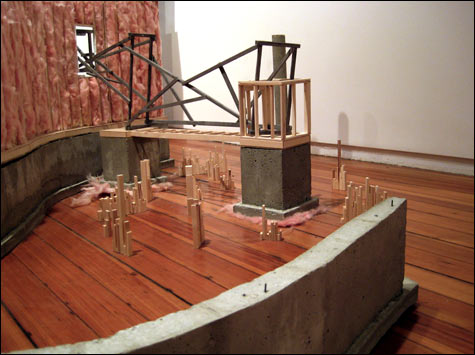
SIMPLE FORMS: A detail from Laustsen's "How to Hold On." |
Jon Laustsen's sculptures are like a contractor's dreams rendered in miniature. In the Woonsocket sculptor's exhibit "How to Hold On" at 5 Traverse Gallery (5 Traverse Street, Providence, through March 14), concrete foundations seem to have gone feral, slithering around, not ready to support anything. Tiny cinder blocks shore up the fractured side of an actual cinder block. Almost all the room inside the wood framing for a doll-house-scale rectangular tower has been given over to an empty central shaft, for a heating and ventilation system. Instead of being subservient to the occupants' needs, the HVAC system has become the building's primary reason for existing. The sculptures are about the nature of building — and surreal mutations.
Laustsen mates model-making with minimalism. Like a good modeler, he's true to form and construction techniques, but at 1/8-scale. His craftsmanship is routinely superb. Minimalism comes in via his simple forms, often placed right on the floor, and the way his mini-towers approach our own height and so challenge our sense of space and scale.
Architecture has become a prominent theme in art in Providence, with the city's highway projects and redevelopment boom, which has forced artists out of studios in old mills. Laustsen's works reflect the local landscape rife with concrete, rebar, wood framing. They're always under construction. There's something about Untitled (Corner Install) with its curving featureless wall that makes me think of Providence Place — but maybe I'm just imaging things.
The pieces here are smaller, more isolated than work he has exhibited over the past year. His elaborate room-filling installation of mini-buildings, including a charred structure, at AS220's Project Space last February drew you in with its sense of ritual and mystery. You wanted to decipher what the purpose of all these structures was. His installation in the show "New Obstructions" at AS220's Mercantile Building last October was a roller coaster-like construction, rising taller than a person, that you could walk through. Its power lay in how it engaged with you physically by taking on your dimensions.
In comparison, his structures at 5 Traverse feel like fragments. They don't grab me in the same way, but they seem to speak more about the nature of building itself.
Also on view at 5 Traverse are photos and videos by Magaly Ponce of Providence. She prints close-up photos of little light bulbs or wiring on rice paper scrolls. The gallery says that Ponce is from Chile, whose chief export is copper, and these works are ruminations on how copper fuels the economy, is used to wire bombs, has been used in torture, and so on. None of this comes through in the work, which seems to be more about beautiful little observations.
That sense of careful observation plays out in a more interesting way in Ponce's video triptych, Hair, Matches, Bugs. On a small monitor at left, someone twists wire around their finger. On the right monitor, a pair of cicadas link butt to butt, making out, as they scurry across concrete. On the center screen, two matches stand balancing against each other atop a matchbook. When they're set alight, the heads of the two matches remain kissing as the foot of the left one lifts into the air, then settles back down again. It's a tiny magical dance. It doesn't exactly stick to the ribs, but it's delightful in its way.
The Wheeler School's Chazan Gallery (228 Angell Street, Providence) offers "Textural Nature," a group show of "emerging artists" (through March 19).
Alice O'Neill of England presents black-and-white photos of a brawny, wet naked dude on a seashore. In some, he wears a horned mask or is covered in white paint, as if in an aboriginal ritual. O'Neill seems to want to create alluring mysteries, but the tone's off. These photos seem like oddball erotica. Jennifer Daltry of Providence makes dreamy etchings and pen drawings of trees, houses, and moons. The scenes could use more specific detail; Daltry simplifies everything to the point that it feels a bit generic. But she successfully evokes the mood of children's fables.
Amelia Hankin of Washington, DC, dazzles with colored pencil drawings and silkscreen prints of bubbly cellular patterns. They have an op-art, psychedelic fizz. Chris Kyle of Lexington, Massachusetts, makes brightly-colored ceramic blobs and lumps decorated with lines, bumps, and spiny things. They resemble charming sea urchins.
Read Greg Cook's blog at gregcookland.com/journal.